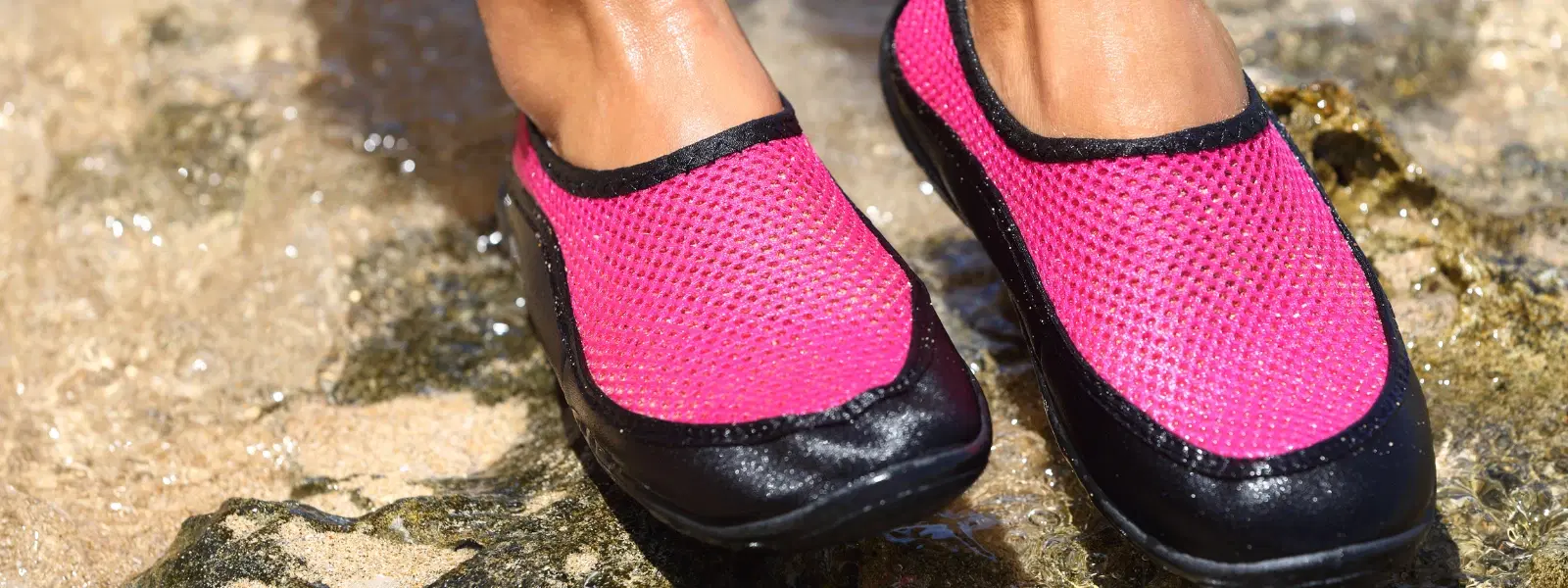
Footwear Guide
•04 min read

Adventuring near water calls for specialized footwear that not only elevates your style but also supports your activities. In this guide, we dive into the details of water shoes versus beach sandals, breaking down the key features, benefits, and ideal uses. Whether you're exploring rocky shores or enjoying a beach day, understanding the differences will help protect your feet and boost your confidence.
Water shoes are crafted for wet and rugged conditions. They feature quick-dry materials and non-slip soles that keep your steps firm even on slippery surfaces. Thanks to their protective coverage, you can comfortably venture into rocky environments or try water sports like kayaking and paddleboarding. These lightweight aquatic shoes are essential for ensuring that every splash is met with secure footing.
Lightweight and breathable design
Non-slip water footwear for safety
Quick-dry technology for swimming
Robust construction for rocky beaches
Beach sandals are all about ease of wear and casual comfort. Their open-toe design allows for ample breathability and a relaxed fit, ideal for a day spent lounging or taking light strolls along the shore. While they offer basic traction, these sandals are less equipped for environments that demand more durable or protective footwear, making them better suited for low-intensity water activities.
Open-toe for maximum breathability
Lightweight construction for effortless mobility
Adjustable straps for a custom fit
Simplistic design for casual outings
When it comes to comfort, both types have their strengths. Water shoes tend to provide a snug fit, which helps in keeping unwanted elements out. This makes them highly effective for prolonged water sports such as paddleboarding or kayaking, where firm, continuous support is necessary. In contrast, beach sandals offer a looser fit that enhances overall comfort during shorter, more relaxed adventures on the beach. Both options cater to different styles of self-expression through the lens of functional fashion.
The grip of your footwear is paramount for safety in wet areas. Water shoes often come with non-slip soles that enhance traction, making them ideal for navigating slippery rocks and wet docks. Beach sandals, though stylish and comfortable, might not offer the same level of dependable traction, particularly on rugged or slippery surfaces. If safety and reliability are priorities, especially in challenging terrains, water shoes stand out as the more protective option.

Durability is a key factor when selecting footwear for adventures in wet environments. Water shoes are designed to endure the challenges of constant moisture and rough terrains. Their construction focuses on longevity even with frequent use in harsh conditions. Beach sandals, by nature of their lightweight and minimal design, may show signs of wear more quickly when exposed to the elements during intense activities.
If you plan on engaging in water sports or exploring variable, rugged terrains, water shoes are the right choice. Their features, such as quick-dry fabrics, non-slip soles, and protective support, make them the best shoes for water activities like kayaking, paddleboarding, or exploring rocky beaches. They ensure your performance is never compromised by slippery feet, giving you the freedom to enjoy every adventure.
Beach sandals are perfect when your day is meant to be more relaxed and stylish. They are best suited for strolling on flat, dry surfaces or having a laid-back day at the beach. Their comfortable design is ideal for casual water play or simply enjoying the sun and sand with ease. These footwear for beach adventures lend an effortlessly chic vibe to your look while keeping you comfortable.
When browsing for the right pair of water shoes, focus on features that will enhance your adventure:
Quick-dry shoes for swimming
Non-slip water footwear to avoid mishaps on wet rocks
Breathable materials that ensure comfort even during long outings
Protective footwear for rocky beaches that shields the foot
With beach sandals, comfort and ease of use come first. Look for these features to ensure you enjoy every moment on the sand:

Adjustable straps for a secure, custom fit
Lightweight design that doesn’t weigh you down
Durable soles suitable for casual walks and low-intensity water play
Pro Tip for Choosing Footwear: Think about the type of terrain and activities you will encounter. For dynamic adventures and slippery surfaces, opt for water shoes equipped with non-slip, quick-dry technology. For relaxed, beachside strolls, a pair of lightweight beach sandals offers both style and ease.
Water shoes are built for wet, rugged environments with features that provide protection and safety, while beach sandals focus on casual comfort for simpler beach outings.
Yes, water shoes offer protective coverage and non-slip soles, which are essential for navigating rocky and slippery terrains.
No, beach sandals do not provide the necessary grip or protective features required for water sports like kayaking.
Absolutely, they are designed with breathable materials and a snug fit that supports extended use in water and on land.
Yes, thanks to quick-dry technology, water shoes typically dry faster than the more open design of beach sandals.
Choosing between water shoes and beach sandals depends largely on your planned adventure. For activities that involve water sports, rocky terrains, or prolonged exposure to wet environments, water shoes deliver on both performance and protection. On the other hand, beach sandals are your go-to for casual, stylish beach outings and relaxed days by the shore. By understanding the core functions and features of each option, you can confidently choose footwear that aligns with both your practical needs and your personal style. Let your footwear be a true expression of your identity as you explore all that water has to offer.